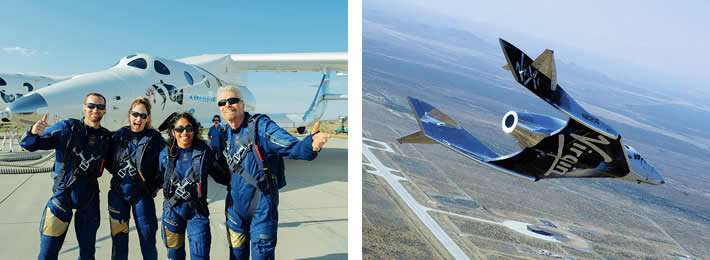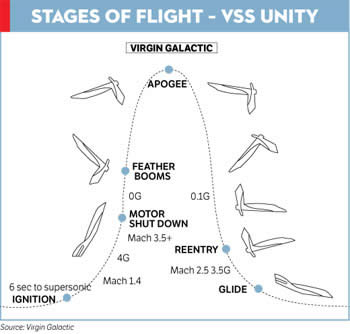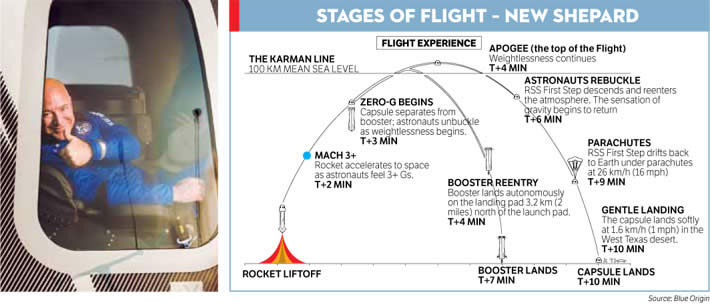INDIAN ARMED FORCES CHIEFS ON
OUR RELENTLESS AND FOCUSED PUBLISHING EFFORTS

SP Guide Publications puts forth a well compiled articulation of issues, pursuits and accomplishments of the Indian Army, over the years

I am confident that SP Guide Publications would continue to inform, inspire and influence.

My compliments to SP Guide Publications for informative and credible reportage on contemporary aerospace issues over the past six decades.
Pacing up to get beyond the borders
With ambitious plans awaiting, for the future of space travel, Blue Origin, Virgin Galactic, SpaceX are transforming the space industry and getting attention on the sector

60 years ago, a historic feat was achieved with Yuri Gagarin becoming the first man to fly in space. As he orbited the Earth, a race to space was witnessed between the superpower nations at that time. A few decades later, while the space missions have witnessed participation from multiple developed and developing nations, the space race now has participation from billionaires as a new era of space travel and tourism begins.
On July 20, 2021, American aerospace company Blue Origin’s New Shepard took its first human spaceflight with its founder, Jeff Bezos aboard the capsule. Just nine days prior to Bezos’ spaceflight another billionaire was seen experiencing moments of weightlessness above the earth’s atmosphere. On July 11, 2021, American spaceflight company, Virgin Galactic’s founder, Richard Branson flew high aboard the VSS Unity for its first fully crewed spaceflight.
VIRGIN VIEW
With the first in-flight livestream by the company, the Virgin Galactic event brought the spaceflight experience virtually to audiences around the world while testing private astronaut and research experience. Though it was the first fully crewed spaceflight, it was the 22nd test flight of VSS Unity. “The crew fulfilled multiple test objectives related to the cabin and customer experience, including evaluation of the commercial customer cabin, the views of Earth from space, the conditions for conducting research and the effectiveness of the five-day pre-flight training programme at Spaceport America,” stated the company.
VSS Unity achieved a speed of Mach 3 after being released from the mothership, VMS Eve. The vehicle reached space, at an altitude of 53.5 miles, before gliding smoothly to a runway landing at Spaceport America from where VMS Eve had taken off to the skies.

As the spacecraft reached the zero G(gravity) moment, Branson telecasted his message, “To all you kids out there — I was once a child with a dream, looking up to the stars. Now I’m an adult in a spaceship with a lot of other adults. If we can do this, just imagine what you can do.”

VMS Eve or WhiteKnightTwo is a four-engine, dual-fuselage jet aircraft, designed to carry SpaceShipTwo up to an altitude of 50,000 feet for an air launch.
VSS Unity, a SpaceShipTwo model, is a reusable, winged spacecraft powered by a hybrid rocket motor – combining elements of solid rockets and liquid rocket engines. The hybrid aims to combine the simplicity of a solid motor with the controllability of a liquid. SpaceShipTwo’s most innovative feature is its unique capability to change its shape in space to ensure a repeatable safe re-entry, highlights the company. By rotating its wings and tail booms upwards while in space, the vehicle’s stability and rate of deceleration in descent is controlled by aero-dynamic forces. Additionally, it is a fully reusable spacecraft, with the exception of the rocket motor’s fuel and oxidizer, which must be replenished after each flight.
“I truly believe that space belongs to all of us. After more than 16 years of research, engineering, and testing, Virgin Galactic stands at the vanguard of a new commercial space industry, which is set to open space to humankind and change the world for good,” stated Branson.
There are no words to describe the feeling. This is space travel. This is a dream turned reality https://t.co/Wyzj0nOBgX @VirginGalactic #Unity22 pic.twitter.com/moDvnFfXri
— Richard Branson (@richardbranson) July 12, 2021
After the successful flight, Virgin Galactic also announced a partnership with “Omaze and Space for humanity to inspire the next generation of dreamers” and invite people to be a part of future spaceflights. The mission specialists in the cabin apart from Branson were Virgin Galactic’s Chief Astronaut Instructor Beth Moses, Lead Flight Operations Engineer Colin Bennett, Vice President of Government Affairs and Research Operations Sirisha Bandla with the VSS Unity pilots being Dave Mackay and Michael Masucci.
Branson carried photos of his family in his pocket to space while other crew members also took personal mementos in connection with their families or their alma mater.
Following this flight, and in line with normal procedures, the team will complete inspections of the vehicles and an extensive data review, which will inform the next steps in the test flight programme. Two additional test flights are planned before the company expects to commence commercial service in 2022.
One of the highlights of the spaceflight was Bandla’s research experiment that was supported by NASA (National Aeronautics Space Administration) and conducted on behalf of a research team at the University of Florida. Her research looks into a plant’s gene expression at different stages of flight. This aimed to be the first human-tended research as part of the Flight Opportunities programme.
BEATING THE BLUES
Blue Origin’s first human flight on July 20 was the 16th flight in New Shepard’s history. Named after the first American to go to space, Mercury astronaut Alan Shepard, New Shepard is a reusable suborbital rocket system designed to take astronauts and research payloads beyond the Kármán line (the internationally recognised boundary of space). New Shepard payload flights have already supported a wide range of research.
It continues to be a great time for commercial space travel! We are encouraged by seeing more people exploring and conducting research in space, and creating a positive impact here on Earth. Congrats to @blueorigin on today’s successful flight, together we’ll open space for good! pic.twitter.com/NFJmFotjnt
— Virgin Galactic (@virgingalactic) July 20, 2021
Here’s the full replay of today’s historic #NSFirstHumanFlight: https://t.co/ecQnSQOiIK
— Blue Origin (@blueorigin) July 20, 2021
Picture perfect landing in the West Texas desert! #NSFirstHumanFlight pic.twitter.com/UXQvzBkq6P
— Blue Origin (@blueorigin) July 20, 2021
Check out some of best photos from today’s historic #NSFirstHumanFlight pic.twitter.com/aqQg0gzxi4
— Blue Origin (@blueorigin) July 20, 2021
With room for six astronauts, the pressurised crew capsule is environmentally-controlled for comfort. This is where the first crew was stationed during this spaceflight. The vehicle is fully autonomous with operationally reusable rockets which “demand high performance engines capable of deep throttling for soft landings”, states the company.
The New Shepard rocket fired into space as the engine kicked off, the crew capsule separated from the rocket, and the booster successfully landed on the ground pad. More than 60 miles above Earth, the crew experienced about three minutes of weightlessness before the crew capsule returned to Earth and made its landing.
SpaceShipTwo’s most innovative feature is its unique capability to change its shape in space to ensure a repeatable safe re-entry
In addition to the founder Jeff Bezos, the New Shepard crew included Jeff Bezos’ brother, Mark Bezos, pilot Mary Wallace Funk, popularly called as Wally Funk and the company’s first paying customer Oliver Daemen. Funk at 82 years of age and Daemen at 18 respectively became the oldest and the youngest person to go to space.
One of the main spotlight of this spaceflight was witnessing Funk finally get to go to space. Her journey to space started in the 1960s “as the youngest graduate of the Woman in Space Program, a privately-funded project which tested female pilots for astronaut fitness. Later known as the “Mercury 13” – thirteen American women successfully underwent the same physiological and psychological screening tests as the astronauts selected by NASA for Project Mercury, but they never got to fly to space. No one has waited longer to go to space,” the company highlighted.

Missions At a Glance
| Missions At a Glance | Virgin Galactic | Blue Origin |
|---|---|---|
| Spaceflight Date | July 11, 2021 | July 20, 2021 |
| July 20, 2021 | 2004 | 2000 |
| Spaceflight Number | 22 | 16 |
| Height travelled | 86 km | 105 km |
| Spacecraft | VSS Unity | New Shepard |
| Launch | Air Launch | Autonomous Rocket Launch |
| Entire Flight Duration | 90 minutes | 11 minutes |
After the return, each crew member was presented with Blue Origin’s astronaut wings to commemorate this remarkable journey. Bezos also unveiled a philanthropic initiative during the post-flight press conference titled the “Courage and Civility Award” of $100 million to recognise “leaders who aim high and pursue solutions with courage who always do so with civility.” Chef José Andrés, and commentator and author Van Jones are the first two awardees.
The crew was seen playing with a skittle during the zero gravity minutes. They also carried with them the goggles with which Amelia Earhart flew across the Atlantic solo becoming the first female to do so. They also borrowed a piece of canvas from the plane the Wright Brothers flew and a bronze medallion made from the first hot air balloon flight from The Explorers Club to take to space.
While acknowledging the team behind the mission, Bezos also thanked the Amazon employees and customers who “paid for this” to happen. When questioned about bringing the cost of space travel down over time so it’s more accessible to everyone, Jeff Bezos said, “You’ve got to do it the same way we did it with commercial airline travel.”
KARMAN LINE
The Fédération Aéronautique Internationale (FAI) established the Karman line, also called the ‘edge of space’ as the boundary separating ‘air-space’ and ‘outerspace’. The Karman line has since been the internationally accepted imaginary line approximately 62 miles (100 kilometres) above the sea level. The US government though considers the outer space beginning from 50 miles high.
In the recent events, Branson’s flight reached above 50 miles. This has attracted questions by many across social media if Virgin Galactic’s flight even travelled to space. On the other hand, Blue Origin’s flight crossed the Karman line to ensure none of their astronauts have “an asterisk next to their name” because “for 96 per cent of the population, space begins at the Karman line”, Blue Origin had earlier remarked.
New Shepard is a reusable suborbital rocket system designed to take astronauts and research payloads beyond the Kármán line (the internationally recognised boundary of space)
However, the astronaut wings presented were only the organisation’s custom-made pins. The crew is not yet accepted as commercial astronauts by FAA. According to the updated rules, in the Commercial Astronaut Wings programme, the FAA noted that to qualify as commercial astronauts, space-goers must travel 50 miles above the Earth’s surface and the would-be astronauts must also demonstrate activities during flight that were essential to public safety, or contributed to human space flight safety”.
In a statement, the FAA said that these changes brought the wings scheme more in line with its role to protect public safety during commercial space flights.
SPACEX
As far as Elon Musk is concerned, he seems to be in a different league altogether with SpaceX rockets going far beyond the Karman Line, taking astronauts and payloads constantly to the International Space Station and gearing up for the missions ahead to the moon and Mars. Having most of its contracts with NASA, SpaceX is continuously evolving its rocket technology. In fact, while the other two were celebrating spaceflights, SpaceX completed the first static fire test of its Super Heavy booster for its new launch system, taking one more step ahead.
First static fire test of Super Heavy booster pic.twitter.com/JtvGMfTgPj
— SpaceX (@SpaceX) July 20, 2021
????Congratulations to the @BlueOrigin team on the first human flight of #NewShepard! We look forward to future flights with researchers and NASA-supported technology payloads aboard. https://t.co/1kiQ1NgNG3
— NASA (@NASA) July 20, 2021
????Spectacular, indeed. Congratulations to the @VirginGalactic team on the successful launch of #Unity22 — your first fully-crewed test flight to space! Onward and upward: https://t.co/Xwdf3OuHu1
— NASA (@NASA) July 11, 2021
From what can be traced, Elon Musk is aiming at making humans an inter-planetary, “spacefaring civilisation” while Jeff Bezos appears more inclined on expanding human’s presence in the orbital space around the earth’s atmosphere, and Richard Branson’s spaceflights come as centered around space tourism giving more and more people an opportunity to get a glimpse of the earth’s edge against the dark black space of the universe. While this spaceflight was a stunt between Bezos and Branson, competition has been high between Bezos and Musk too especially seen recently in getting a deal with NASA for the moon missions. The founders and companies have often taken on each other through social media and at the outset maintained camaraderie too about there not being any competition or race as space is for all.
Many people have criticised the recent spaceflights as a waste of money because of the billionaire founders’ faces attached. At the same time space enthusiasts in contrary have not remained calm in applauding the flights. Whether it really is a race amid these billionaires or not can’t be ascertained but these endeavours are surely opening doorways for space travel like never before. Those with more money do have the privilege to access any new advancement but because they dare to take the leap with something, it eventually expands to the masses. With special emphasis laid on the windows by both Blue Origin and Virgin Galactic, the attraction to take people in space and let them witness the overview of earth in the backdrop of the black space is the central attraction. While Blue Origin claims to have the largest windows for panoramic views, Virgin Galatic’s spaceplane has the highest number of windows to allow each passenger the access.
With more enthusiasm and optimism in the prospect for the space market, private sector forecasters anticipate growth forecast to be between $1 and $1.5 trillion by 2040
NASA too joined in to congratulate the companies on their spaceflights.
The space sector is a rapidly expanding and outer space has become an intrinsic part of today’s geopolitics as well. NSR’s Emerging Space Investment Analysis, 3rd Edition report (ESIA3) released earlier this year shows $7.7 billion in funding was raised in 2020 alone, bringing the total since 2000 to nearly $36 billion. With more enthusiasm and optimism in the prospect for the space market, private sector forecasters anticipate growth forecast to be between $1 and $1.5 trillion by 2040.
While their goals might vary to some extent, the core idea of expanding the awareness, curiosity and accessibility of space certainly seems to be central to all three (Blue Origin, SpaceX, Virgin Galactic). The forms might be different but the three are surely launching a new era of spaceflight for future generations. Going ahead space sector holds promise, benefits and opportunities in multiple manners and this “race” can be a positive step in that direction.





